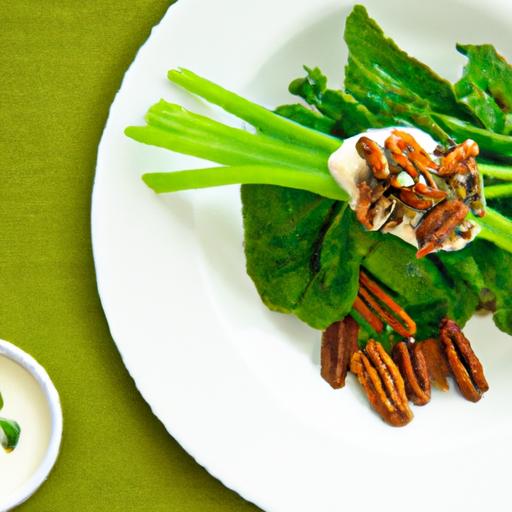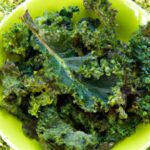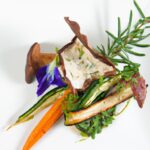Beneath the canopy of towering trees and amidst the quiet whispers of meadows, nature conceals a vibrant treasure trove: wild greens. Often overlooked in favor of their cultivated cousins, these untamed leaves and shoots are bursting with nutrients, offering a powerful boost to health and vitality. From the delicate fiddleheads unfurling in spring to the hearty dandelion greens thriving in urban corners, wild greens are nature’s nutrient-packed superfoods waiting to be unveiled. Join us as we explore their rich flavors, remarkable benefits, and the sustainable ways we can forage these edible delights-inviting you to reconnect with the earth’s pantry and nourish your body with the purest gifts of the wild.
Wild Greens Unveiled: Nature’s Nutrient-Packed Superfoods
Wild greens unveiled bring a fresh twist to your kitchen, bursting with unique flavors and unparalleled nutritional benefits that most store-bought vegetables simply can’t match. For centuries, wild greens have been treasured by cultures worldwide, offering an abundant source of vitamins, minerals, and antioxidants. Inspired by my hikes through lush forests and sun-dappled meadows, this recipe celebrates the bounty found just beyond our doorsteps – transforming humble foraged leaves into a dazzling, health-enhancing dish you’ll want to make again and again.
Prep and Cook Time
Preparation: 15 minutes
Cooking: 10 minutes
Total: 25 minutes
Yield
Serves 4
Difficulty Level
Easy – Perfect for beginners interested in exploring wild greens
Ingredients
- 4 cups mixed wild greens (such as dandelion, nettle, chickweed, and purslane), thoroughly washed and chopped
- 2 tablespoons extra virgin olive oil
- 3 cloves garlic, finely minced
- 1 small shallot, thinly sliced
- 1 tablespoon fresh lemon juice
- 1 teaspoon sea salt
- ½ teaspoon freshly cracked black pepper
- 2 tablespoons toasted pine nuts, for garnish
- Optional: 1 teaspoon red chili flakes for a gentle spicy kick
Instructions
- Prepare your wild greens: After giving your wild greens a thorough rinse to remove any grit, spin them dry or pat them carefully with paper towels. Chop roughly to keep the leaves vibrant and textured in the final dish.
- Heat olive oil: Warm the olive oil in a large skillet over medium heat. Add the minced garlic and sliced shallot, sautéing until fragrant and translucent, about 2-3 minutes. Stir regularly to avoid burning.
- Sauté greens: Add the chopped wild greens to the skillet. Toss gently to coat in the infused oil and cook until just wilted, about 5 minutes. Use a wooden spoon to move them frequently, ensuring even cooking without releasing too much liquid.
- Season: Stir in sea salt, freshly cracked pepper, and optional chili flakes. Finish with lemon juice, which brightens the earthy flavors and enhances nutrient absorption.
- Plate and garnish: Transfer your wild greens to a serving bowl or plate. Sprinkle toasted pine nuts on top for a delightful crunch and nutty aroma.
Tips for Success
- Identifying safe wild greens: Always harvest from areas free of pesticides or pollutants. Use a wild plant guidebook or app to confirm edible species and avoid poisonous look-alikes.
- Substitutions: If you can’t find wild greens, baby spinach or kale make excellent alternatives but aim for the wild variety to maximize nutrition.
- Make-ahead: This dish is best served fresh but can be refrigerated in an airtight container for up to 2 days. Reheat gently to preserve texture.
- Flavor variations: Add a sprinkle of grated Pecorino Romano or a drizzle of balsamic glaze before serving for an extra flavor layer.
Serving Suggestions
This vibrant sauté of wild greens pairs beautifully with a rustic whole grain bread or as a nutrient-rich side to grilled fish or roasted chicken. Garnish with fresh edible flowers or microgreens for an elegant touch. To create a complete meal, consider incorporating wild greens into a warm quinoa salad or tossing them through a hearty pasta dish for a nutrient-packed boost. For a refreshing contrast, serve alongside a chilled glass of dry white wine or sparkling mineral water infused with herbs.

| Nutrient | Per Serving |
|---|---|
| Calories | 120 |
| Protein | 4g |
| Carbohydrates | 8g |
| Fat | 9g |
For deeper insight into the health benefits and foraging tips, visit Wild Edible Plants. You can also explore more creative uses of seasonal greens in our Seasonal Green Salads Collection.
Q&A
Q: What exactly are wild greens, and why are they considered nature’s superfoods?
A: Wild greens are edible plants that flourish untamed in forests, fields, and along riverbanks – think dandelion leaves, nettles, chickweed, and purslane. They are nature’s nutrient-packed powerhouses, often boasting higher concentrations of vitamins, minerals, and antioxidants than their cultivated cousins. These greens have been nourishing humans for millennia, quietly packing a serious health punch straight from the wild.
Q: How do wild greens compare nutritionally to conventional leafy vegetables?
A: Wild greens frequently outshine supermarket staples like spinach and kale in certain vitamin and mineral content. For example, nettles can contain more iron than spinach, and purslane is rich in omega-3 fatty acids – a rarity in plant foods. Their diverse nutrient profiles and unique phytochemicals offer a vibrant palette of health benefits that conventional greens might lack.
Q: Are wild greens safe to eat, and how can beginners identify them?
A: Safety is key! While many wild greens are delicious and nutritious, some plants can be toxic or look deceptively similar to edible varieties. It’s essential for beginners to study field guides, attend foraging workshops, or consult experienced foragers before harvesting. Starting with well-known plants like dandelion or chickweed and avoiding those near polluted areas is a great way to ease into this leafy adventure.
Q: What are some simple ways to prepare wild greens to maximize their flavor and nutrients?
A: Wild greens often have strong, unique flavors that shine when treated with a bit of culinary creativity. Lightly sautéing nettles after blanching removes sting and brings out a spinach-like taste. Adding raw purslane or chickweed to salads provides a crisp, peppery punch. Wild greens also meld beautifully into pesto, smoothies, or infused teas, letting you enjoy their nutrients in versatile, tasty forms.
Q: How can incorporating wild greens into your diet impact your health and the environment?
A: Embracing wild greens not only supercharges your plate with vitamins, minerals, and antioxidants, but it also connects you with the natural world in a sustainable way. Foraging encourages outdoor engagement and reduces reliance on industrial agriculture, cutting down on food miles and packaging waste. In essence, wild greens offer a win-win: nourishing your body and honoring the earth’s abundance.
Q: Where can readers learn more and start foraging safely?
A: To dive deeper, reputable books on wild edibles, local foraging groups, and nature centers are invaluable resources. Apps that identify plants can aid beginners but should never replace hands-on learning. Most importantly, always practice ethical foraging: harvest sustainably, respect private property, and leave enough for wildlife to thrive. With curiosity and care, your journey into wild greens can become a lifelong, flourishing love affair with nature’s superfoods.
In Summary
As we peel back the leafy layers of wild greens, we uncover more than just humble plants-they are nature’s vibrant pantry, bursting with nutrients that have fueled civilizations for centuries. Embracing these wild superfoods not only reconnects us with the earth’s rich biodiversity but also invites a fresh, nourishing twist to our modern plates. So next time you wander through a field or forest, remember: a treasure trove of health and flavor might be growing right beneath your feet, waiting to transform your meals and your wellbeing. Wild greens aren’t just food-they’re nature’s green gift, ready to be savored and celebrated.


